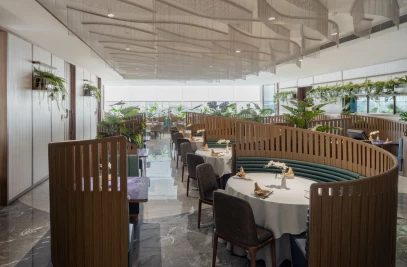Noodle soup is a common street food all over China. While most of these noodle joints spend tremendous effort to win customers with taste, some has started to add attractive store design into their branding recipe. A good example is Long XiaoBao, a newcomer who sets foot in Changsha with an ambition to spread the local ShaoYang style rice noodle to the rest of China. Commissioned to conceive a contemporary identity for their first restaurant, Lukstudio integrates the tradition of noodle making in the spatial design by reinterpreting a noodle rack. Nestled along an outdoor shopping promenade nearby the Xiangjiang River, the 50-sqm noodle joint exudes a calm yet mysterious presence with its bamboo-cast concrete storefront. Two rustic steel boxes penetrate through the solemn exterior: the taller one is cladded with rusted steel panels and its shorter neighbor is built like a metal scaffold.These three elements together orchestrate a journey of discovery. Walking past the entry box, a customer is greeted by a composed counter design lined with the bamboo mold used for casting the exteriors. As one proceeds towards the halo surrounding the grid structure, the interior layers start revealing themselves. Firstly, the original wall is stripped down to its structural blocks to resonate with the rustic metal grid. Secondly, wooden boxes are carefully placed within the rack to showcase selected porcelains. Finally, a series of metal wires are draped across the dining room to create the lighting feature with hanging bulbs. Balancing the rustic interiors, these reflective strands create a poetic notion of dining under a noodle rack. Playing with the duality between rustic and refined, eastern tradition and western representation,Lukstudio introduces a crossover between fast food chain and upscale diner. The Noodle Rack differentiates itself from the stigma of kitsch fast food “hole in the wall”on every street of China. It demonstrates how Chinese eateries have the potentials to be reborn into hip gathering spots comparable to the new trend of cafés.
Project Credits
Products Behind Projects
Product Spotlight
News

Fernanda Canales designs tranquil “House for the Elderly” in Sonora, Mexico
Mexican architecture studio Fernanda Canales has designed a semi-open, circular community center for... More

Australia’s first solar-powered façade completed in Melbourne
Located in Melbourne, 550 Spencer is the first building in Australia to generate its own electricity... More

SPPARC completes restoration of former Victorian-era Army & Navy Cooperative Society warehouse
In the heart of Westminster, London, the London-based architectural studio SPPARC has restored and r... More

Green patination on Kyoto coffee stand is brought about using soy sauce and chemicals
Ryohei Tanaka of Japanese architectural firm G Architects Studio designed a bijou coffee stand in Ky... More

New building in Montreal by MU Architecture tells a tale of two facades
In Montreal, Quebec, Le Petit Laurent is a newly constructed residential and commercial building tha... More

RAMSA completes Georgetown University's McCourt School of Policy, featuring unique installations by Maya Lin
Located on Georgetown University's downtown Capital Campus, the McCourt School of Policy by Robert A... More

MVRDV-designed clubhouse in shipping container supports refugees through the power of sport
MVRDV has designed a modular and multi-functional sports club in a shipping container for Amsterdam-... More

Archello Awards 2025 expands with 'Unbuilt' project awards categories
Archello is excited to introduce a new set of twelve 'Unbuilt' project awards for the Archello Award... More

























